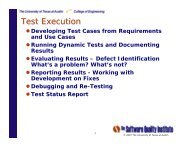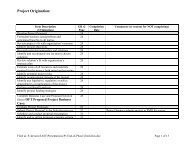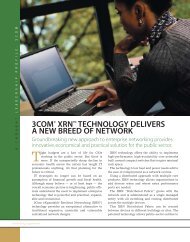Unify Your Backup and Recovery Strategy with LiteSpeed® for SQL ...
Unify Your Backup and Recovery Strategy with LiteSpeed® for SQL ...
Unify Your Backup and Recovery Strategy with LiteSpeed® for SQL ...
Create successful ePaper yourself
Turn your PDF publications into a flip-book with our unique Google optimized e-Paper software.
<strong>Unify</strong> <strong>Your</strong> <strong>Backup</strong> <strong>and</strong> <strong>Recovery</strong> <strong>Strategy</strong> <strong>with</strong> <strong>LiteSpeed®</strong><br />
<strong>for</strong> <strong>SQL</strong> Server <strong>and</strong> <strong>LiteSpeed®</strong> Engine <strong>for</strong> Oracle<br />
DEVELOPING A BACKUP AND RECOVERY STRATEGY<br />
Requirements<br />
A backup <strong>and</strong> recovery strategy must address both the data growth issue <strong>and</strong> the<br />
security issue. Specifically, a good database backup <strong>and</strong> recovery strategy must do<br />
all of the following:<br />
4<br />
1. Provide a similar level of service <strong>for</strong> all plat<strong>for</strong>ms<br />
2. Enable the DBA to maintain control over the backup <strong>and</strong> recovery<br />
operations <strong>and</strong> over the backup files themselves<br />
3. Maintain data security<br />
4. Minimize storage needs<br />
5. Minimize backup times<br />
6. Minimize recovery times<br />
Most of these points are obvious, but the second point—DBA control—is often<br />
overlooked. If per<strong>for</strong>ming a backup <strong>and</strong> recovery requires more than one group,<br />
then both the chances of error <strong>and</strong> the average human response time will increase<br />
dramatically. Ideally, a single DBA should be able to per<strong>for</strong>m a complete backup<br />
<strong>and</strong> recovery operation alone, <strong>with</strong>out needing to coordinate <strong>with</strong> or enlist the aid<br />
of someone in another group.<br />
<strong>Backup</strong> <strong>and</strong> <strong>Recovery</strong> Methods<br />
Database backup <strong>and</strong> recovery methods can be divided into these four categories:<br />
1. Native database backup utilities<br />
2. Disk-storage system split-mirroring<br />
3. Tape-storage system backup via DB agent<br />
4. Third-party database backup software<br />
For an in-depth look at the relative advantages <strong>and</strong> disadvantages of each, see the<br />
Quest white paper <strong>Backup</strong> <strong>and</strong> <strong>Recovery</strong> Options in a Multi-Plat<strong>for</strong>m Environment.<br />
The conclusion of that paper is that only a third-party product <strong>with</strong> the appropriate<br />
set of features is really capable supporting a backup <strong>and</strong> recovery strategy that<br />
effectively addresses all six needs listed above.

















